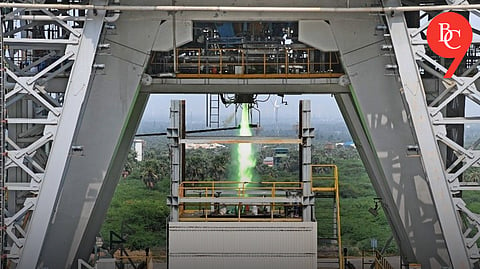

The Indian Space Research Organisation (ISRO) has marked a historic milestone in its semicryogenic engine development program with the first successful hot test of the 2000 kN Semicryogenic Engine Power Head Test Article (PHTA). Conducted on March 28, 2025, at the ISRO Propulsion Complex (IPRC) in Mahendragiri, Tamil Nadu, this achievement paves the way for enhancing the payload capacity of India’s heaviest launch vehicle, the LVM3, and positions the nation among elite spacefaring countries.
The SE2000 engine uses Liquid Oxygen (LOX) and Kerosene propellants, offering non-toxic, cost-effective, and high-performance propulsion.Operates on an oxidizer-rich staged combustion cycle with a chamber pressure of 180 bar and a specific impulse of 335 seconds.Designed to replace the existing L110 core stage of the LVM3 rocket, the new SC120 booster stage will increase payload capacity from 4 tonnes to 5 tonnes in Geosynchronous Transfer Orbit (GTO).
Validated critical subsystems like pre-burners, turbo pumps, control components, and the startup system.The 2.5-second hot test confirmed smooth ignition and stable operation in booststrap mode, meeting all performance parameters.Followed rigorous testing of the Pre-burner Ignition Test Article (PITA) to refine the ignition sequence.
Conducted at the Semicryogenic Integrated Engine Test Facility (SIET), inaugurated by PM Narendra Modi in February 2024.SIET can test engines up to 2600 kN thrust, equipped with advanced control systems and high-precision data acquisition tools.
The breakthrough follows earlier tests in July 2023, where ISRO encountered turbine pressure spikes during a 4.5-second PHTA test. Lessons from these trials informed design refinements, culminating in the March 2025 success.
With this advancement, India joins a select group of nations—including the US, Russia, and China—capable of developing high-thrust semicryogenic engines. ISRO Chairman S. Somanath hailed the achievement as a “quantum leap” in propulsion technology.
